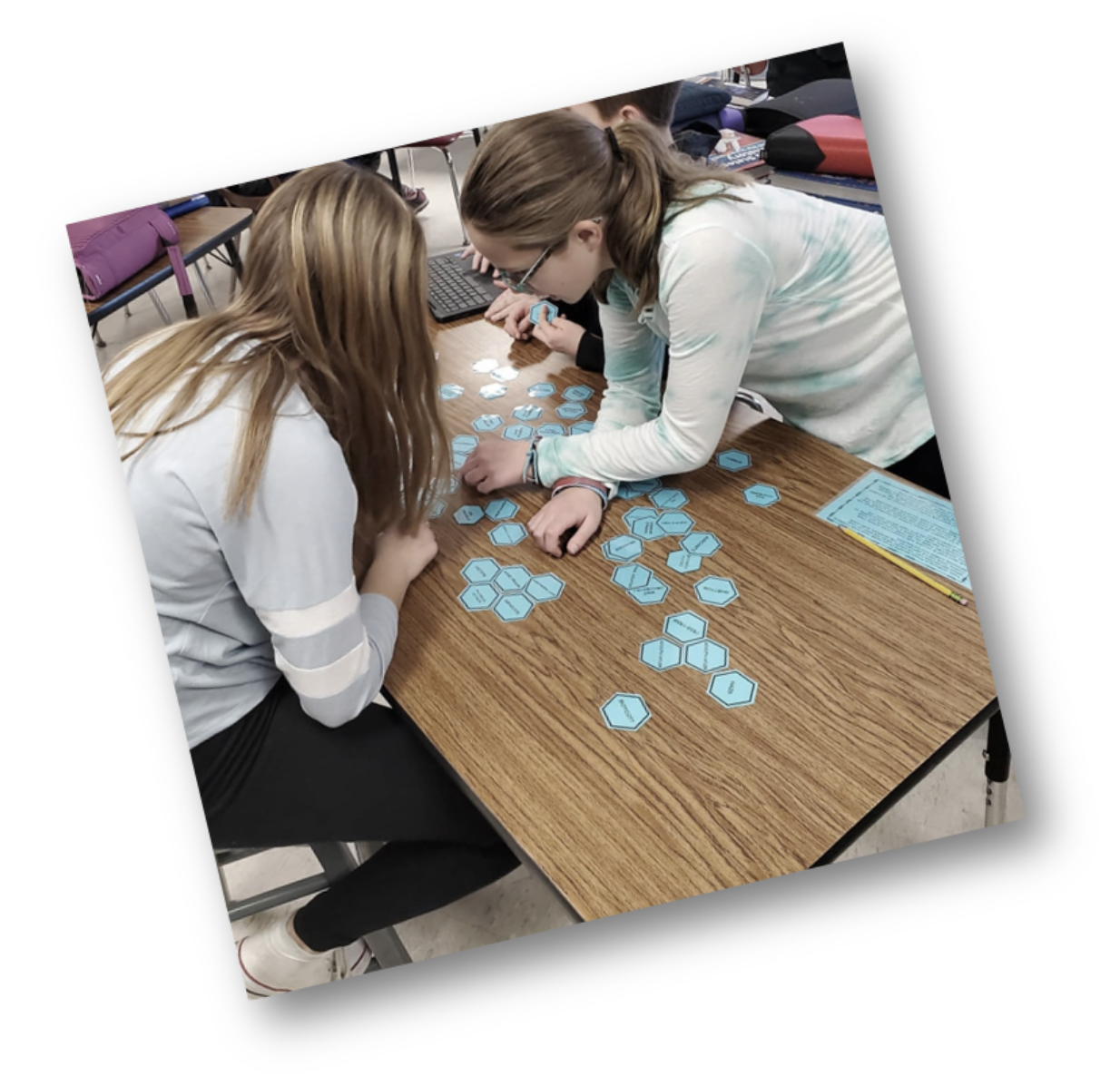
I’ve always admired Lea Hansen’s Instagram stream. When she started posting about hexagonal thinking in middle school, it got me thinking about all the ways this process incorporated critical thinking. Read on to see how she utilizes this thinking strategy in her Social Studies classroom.
I’m a little addicted to hexagonal thinking activities. After attending a professional development conference and learning about hexagonal thinking in the classroom, I decided to give it a try in my classroom. If you’re not familiar with hexagonal thinking, it’s a way for students to organize their thinking visually. In addition, hexagonal thinking promotes deep thinking about a topic as students both organize content into categories and build connections between different ideas.
If you would like to incorporate hexagonal thinking activities in your classroom but are unsure how to start, I’ll share a few examples of how I do it step-by-step.
Using a Hexagonal Thinking Activity as a Formative Assessment
First, I create my hexagonal cards using people, places, events, and vocabulary from my unit. I made my own template but you can also find templates online.
I laminate my cards and have my student assistant cut them out in advance. I laminate my cards because I reuse them and want them to last. (I strongly suggest cutting cards out in advance as well as enlisting the help of a student assistant. You don’t want to waste valuable class time cutting out cards!) I always leave at least a half-dozen cards blank for students to write their own terms.
I create seven sets of cards; one set for each group of three to four students. (I prefer smaller groups because I want to ensure ALL students participate. Based on past experience, the larger the group, the more likely a couple students will take-over and your shy students will fade into the background.)
Once students are in their groups, I explain the activity. (I also include an instruction sheet in each envelope with the cards for students to use as a reference.) When I explain the activity to my students, I demonstrate how to use the cards by holding up the cards and demonstrating how I would connect three or four random cards.
It is also helpful to have an image of a completed “cluster” to share with students on your smartboard. I project an image of a “cluster” created by another class on another topic.
I explain to my students that the first thing they need to do in their groups is set aside all the “big idea” cards. “Big idea” cards could also be called “headings.” For example, I often include cards for each of the 5 themes of Social Studies (History, Government, Geography, Culture, Economics) in my Geography hexagonal thinking sets. In my Holocaust hexagonal thinking set I included the terms, “perpetrator,” bystander,” victim,” “collaborator,” and “rescuer/upstander” as big ideas.
Once students have set aside all of the “big idea” cards, they should start sorting their remaining cards into categories. After students have arranged most of their cards into categories they should start building connections among the cards. The goal is to connect all or most of their cards within the time allotted.

One of my favorite aspects of hexagonal thinking activities is that students quickly realize there are multiple ways to connect cards. I encourage students to make choices on their placement of cards which allow for the strongest connections between cards. (While students are working in their groups, I circulate around the classroom offering support to students who are struggling and pushing others to explain their reasoning behind certain connections.) For students who are struggling, I encourage them to start with a few terms they are familiar with and build from there. With a little encouragement and helpful suggestions, struggling students quickly gain confidence once they see their clusters grow!
Another aspect of the activity that I love is that it allows for some pretty stimulating group discussion. As group members maneuver the cards into position, they are forced to articulate their reasoning behind their connections. Group members do not always agree on the linkages. Listening to students justify their choices helps me as an educator understand how deeply my students understand the material as well as which material I may need to review.
If students are struggling with some of the terms, I encourage them to first consult their teammates. If everyone in the group is struggling with a term, I allow students to use their textbook and the internet as resources.
Using Hexagonal Thinking as Part of a Stations Activity
I recently created a stations activity for my Geography students focusing on Ancient Greece. Whenever I create a stations activity for my Geography students, I include activities that focus on the 5 themes of Social Studies. It seemed a no-brainer to include a hexagonal thinking station.
Basically, my hexagonal thinking exercise was the same as my regular hexagonal thinking activity except shorter. (I didn’t create as many cards and I set a time-limit of 15 minutes.) After 15 minutes working at the hexagonal thinking station, students answered a few questions on their recording sheet reflecting on the exercise. I asked, “Which cards had the most connections? Did you struggle to form connections with some cards and if so, which ones?”
Using Hexagonal Thinking as a Summative Assessment
If you are going to use a hexagonal thinking exercise as a summative assessment, you could either allow students to work independently or with a partner. Depending on your schedule, you could allow class time to complete this activity or assign it as homework. If you allow class time to complete, it is recommended that students cut out their cards at home or during their study hall.
For a summative assessment, once students finalize their card placement, they will glue all of their cards in place on a large sheet of butcher paper. Then, students should “mark-up” their cards using color pencils or markers. I ask my students to annotate their cards using symbols for different types of historical thinking. For example, (C & E) Cause and effect, change and continuity (C&C), turning points in history (TPH). I also require my students to create some of their own cards with vocabulary, names, places, events, etc. that they think is important that I did not include in the set I gave them.
One last suggestion regarding hexagonal thinking in the classroom is to use student projects as anchor charts to hang in your classroom! (I haven’t done this yet but I am eager to do so the next time I assign a hexagonal thinking activity as a summative assessment!)
I would love to hear from other educators how you incorporate hexagonal thinking activities into your classrooms!
About Lea:
Lea Hansen lives with her husband, two children, and dog in the gorgeous Driftless Region of Southwest Wisconsin. She has been happily teaching middle and high school social studies for 18 years. She is passionate about Social Studies and strongly committed to providing engaging, creative, and meaningful lessons to the students she serves.
Visit her TpT Store to find more Social Studies Hexagonal Thinking and Stations Activities!

3 Responses
Are you willing to share/sell some of the cards that you have created that go along with the five themes of geography or Ancient World History?
Thanks
I haven’t created any for either of those topics. Those that have been created aren’t in the Peacefield History store. Instead, they’re included in a TpT store called the Social Studies Toolbox.
Are your products editable, for example I need to translate them from english to my language? I love this one for Holocaust, and saw that you have a whole bundle of hexagonal thinking activities… Thank you. 🙂